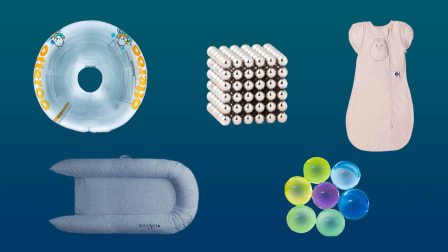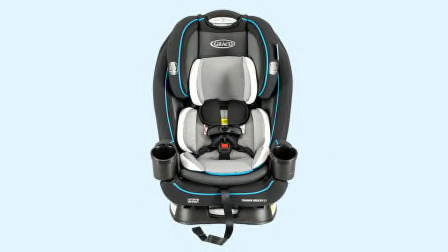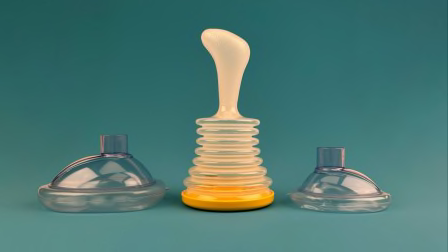Is It Safe to Buy a Used Car Seat, Stroller, or Crib for Your Baby?
Consumer Reports' experts weigh in, and offer advice for buying some of the most big-ticket baby products, new or used
When you shop through retailer links on our site, we may earn affiliate commissions. 100% of the fees we collect are used to support our nonprofit mission. Learn more.

With all the joys of having a baby comes lots of shopping for lots of stuff. As far as strategy goes, you have two options: Buy new products or get them secondhand, whether that means cruising Facebook marketplace or accepting hand-me-downs from a loved one.
It makes sense to want to buy used baby products. Your baby won’t need this gear for very long, and you have to buy so much of it that costs mount quickly—nabbing something off Craigslist or accepting a freebie has obvious appeal.
In This Article
Infant Car Seats • Strollers • Cribs • High Chairs • What to Do About Recalls • Dangerous Baby Products
That said, you might not be able to register used products to find out about recalls and other important notices. When products are recalled, it’s because they pose serious safety hazards or don’t meet current standards. To be sure a used product is safe before bringing it home, you could look it up on the public database of incidents reported to the Consumer Product Safety Commission, the federal agency that oversees thousands of household products.
Recalls are one reason to opt for new rather than used baby gear. You’ll be notified of any recalls when you purchase and register a new product, notes Ashita Kapoor, associate director of CR’s product safety.
Another argument for spending more money on a new product? You get the latest advancements on the market. “A child’s safety is the utmost priority for any parent,” says Kapoor. “It is important to always buy the latest versions or models of the product to ensure the product is meeting the latest safety standards.”
Infant Car Seats
While all car seats must pass minimum federal safety standards, some may provide additional margins of crash protection, and some are easier to install than others. That’s crucial, considering a poorly installed car seat leaves a child vulnerable in a crash.
“Those reasons, along with continuous ease-of-use and safety improvements, make a strong case for investing in a new, top-performing car seat,” says Emily A. Thomas, PhD, manager of auto safety at Consumer Reports Auto Test Center.
The life span for most car seats is six to 10 years. In most cases, an expiration date is printed underneath the seat—make sure you’re abiding by it, as a car seat outside its expiration date won’t provide the protection of a newer model.
If you’re buying or inheriting a secondhand car seat, use our interactive decision chart to find out whether the seat is safe to reuse. In addition to the seat’s expiration date—which ensures that the seat hasn’t become too worn—you’ll also want to check whether the car seat has been involved in a crash, which could weaken the seat’s structural integrity beyond what you can see.
Should you end up with a car seat that’s not safe to reuse, don’t haul it to the curb or town dump—it might tempt strangers to use it for their baby. Instead, strip the car seat to its shell, removing fabrics, harnesses, and buckles. Then mark “Do Not Use” on it, and check with your local authorities to find out whether any components can be recycled before you dispose of the car seat.
Best Infant Car Seats Under $200
These three infant car seats earn our recommendation and typically sell for less than $200. If these don’t fit your needs, we rate 30 other infant seats in our car seat ratings.
Don’t forget about another important safety consideration: installing the seat properly in your car. Find out the common car seat installation mistakes to avoid.
Strollers
Strollers may not have an expiration date like car seats, but you’ll definitely want a model that was made after Sept. 10, 2015. That’s when federal safety standards became mandatory, covering proper harness placement and the integrity, stability, and strength of strollers, among other factors. A label on the underside of the frame should show the manufacture date.
Then check the owner’s manual to make sure the stroller operates properly. Inspect the stroller, making sure the seat reclines properly and the brakes work. For example, if the stroller has swivel wheel locks, try them out to be certain they do not stick in an unlocked or locked position.
“Make sure the stroller folds and unfolds properly, using the directions in the owner’s manual. As you continue to read through the manual, try each feature to be sure the stroller is in good working order,” says Joan Muratore, the engineer who oversees CR’s stroller tests “Finally, examine the entire frame for dents or cracks, or missing bolts or other hardware.” If you don’t have the original manual, look for it through a search engine, on the manufacturer’s website, or call the company’s customer service number.
Best Strollers Under $250
We’ve tested strollers that cost as much as $1,400, but these three CR-recommended models from our tests cost far less. That said, if they don’t fit your needs, we rate 24 other strollers in our stroller ratings.
Cribs
If you plan on buying or borrowing a used crib, we recommend looking for a stationary-side crib manufactured after 2011. That’s when new federal safety standards went into effect that banned drop-side cribs, which tended to be less sturdy than cribs with four fixed sides. “Once drop-side cribs were banned, injuries and fatalities dropped dramatically,” Kapoor says.
A crib’s hardware can also be weakened by rough use or changes in humidity during storage—keep this in mind if you plan to shop for one secondhand.
Check the crib for a label that includes the manufacturing date or lot code, as well as the manufacturer’s contact info. Typically, these codes appear in a discreet spot on the crib frame, or underneath the mattress support. If you can’t decipher the manufacturing date from the lot number or lot code, call the manufacturer and ask. Importantly, if there’s no clear label, don’t use the crib.
Remember that the safest crib is a bare crib: Use only a firm, flat, non-inclined surface (inclined surfaces can cause babies to suffocate). Babies should sleep by themselves in their crib. Remember they can roll into crevices, such as between a mattress and a headboard, or be smothered by pillows or a parent rolling over. Finally, don’t put toys, crib bumpers, blankets, pillows, or other products into the crib—they can suffocate babies.
Best Cribs Under $200
These three cribs earn decent scores in our ratings (though none are CR-recommended), and they all sell for less than $200. If they don’t fit your needs, we rate 10 other cribs.
High Chairs
If you’re buying a high chair secondhand, make sure it was made after June 2019, when the CPSC mandated that all high chairs sold in the U.S. meet a federal safety standard that incorporates the ASTM International F404 high chair standard. You won’t find an official label noting that the high chair meets this standard, but you should be able to find the model’s name and the date of its manufacture on a label affixed to the chair. You should also check CPSC to be sure it hasn’t been included in any safety recalls.
We recommend looking for these safety features in your high chair, whether it’s new or used: a crotch post; a safety-restraint system with a five-point harness (ASTM International’s current safety standards require only a three-point harness for certification, but the five-point type is safer because it can keep a child from standing or leaning over in a high chair and possibly falling or tipping the chair over); if you want a chair with wheels, make sure it has locks or uses casters; and if it’s a folding high chair, make sure it won’t pinch your fingers when you’re closing it.
Best High Chairs Under $200
We’ve tested more than 15 high chairs, and these three, which all sell for less than $200, all performed best within that budget.
What to Do About Product Recalls
While many kinds of baby products have to undergo safety testing before they become available to the public, others lack mandatory safety standards, reports CR’s Lauren Kirchner.
And while it’s illegal to sell recalled products, the CPSC prioritizes compliance from major retailers rather than the resale market. If you’re shopping secondhand marketplaces, there’s no way to know for sure if a product you’re considering is recalled, aside from searching online for the individual model.
This means that you should research the safety of the product before you buy it. Kirchner recommends looking things up on the public database of incidents reported to the CPSC.
Dangerous Baby Products to Avoid—New or Used
CR’s safety experts have identified five products that you should avoid as you prepare to welcome your baby into the world.
- Infant ‘loungers’ have been found to have pillowy sides that look like good protection but can actually pose a risk of suffocation for babies
- The support straps on Cosco’s Jump, Spin & Play Activity Centers have come unhooked with babies still inside, causing them to dangle sideways or fall onto the floor
- Otteroo’s ’Neck Floats’ are meant to hold your baby’s neck above water, but CPSC has heard dozens of complaints of babies slipping through their floats and into the water below
- Medical experts say that weighted baby blankets, swaddles, and sleep sacks should never be used on a baby at the risk of inhibiting the baby’s breathing
- Water beads, like Target’s Chuckle & Roar Ultimate Water Beads Activity Kits, are gel balls that expand when watered. Water beads expand inside the body when swallowed, causing vomiting and life-threatening bowel obstruction
Additionally, CR has a more detailed guide to inclined sleepers, nappers, and loungers that have been recalled. Sleepers, which position infants at an angle between 10 and 30 degrees, can allow a baby’s head to slump forward, blocking airflow, and make it easier for a baby to roll over into the sleeper’s sidewalls or head rest, interfering with breathing. Among those listed are the Fisher-Price Rock’n Play Sleeper, which was recalled in 2019 after more than 30 reported fatalities, and the Kids II Rocking Sleepers, which were also recalled in 2019 after five infant fatalities.




















